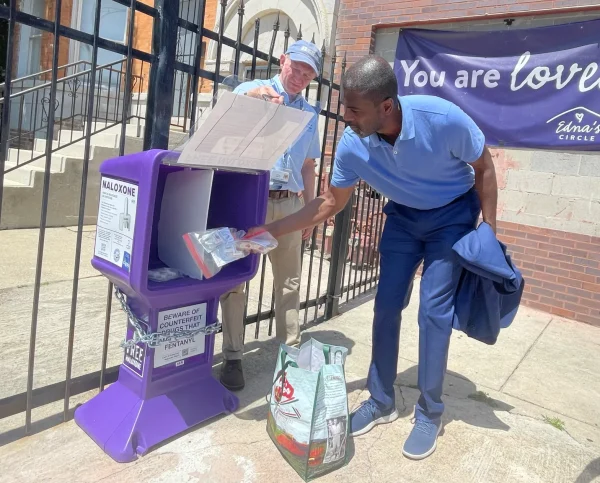By Francia Garcia Hernandez
A dozen medical experts, outreach workers and advocates joined state Rep. La Shawn K. Ford last week in his push to open a pilot overdose prevention site in Chicago, possibly on the West Side.
Standing at the corner of West Van Buren Street and South Pulaski Road, one of many West Side areas with high overdose rates, Ford called for the public and lawmakers to support a bill that would allow the creation of overdose prevention sites in Chicago.
“Overdose prevention sites are evidence-based healthcare where people can use pre-obtained drugs,” Ford said. “If an individual overdoses, someone will save their life and connect them to a number of local resources.”
The site could serve not only as a healthcare center but as a center that provides wraparound services to people who use drugs, simultaneously addressing many of the barriers that people with substance use disorders face.
“The message that often gets lost in the conversation is that these sites provide essential services, such as psychotherapy, medication assisted treatment, recovery, coaching, medical care, job training, food aid, shelter, legal support and other basic needs,” Ford said.
Equally important, it would help save lives. Last month, a Cook County medical examiner report confirmed a record 2,000 opioid overdose deaths in Cook County in 2022.
Vincent Lee, a West Side resident, recently lost his first cousin, age 50, to an overdose after he moved out of state.
“If someone would have been there with naloxone, they could have probably saved his life,” Lee said.
Overdose prevention sites in New York helped save about 700 lives last year.
Around the world, there has never been a death due to overdose in an overdose prevention site, said Sophia Payne, an addiction medicine and internal medicine physician at Rush Hospital. It could also help save taxpayers $3 million every year by decreasing the number of emergency management service calls in Chicago.
Members of several community and healthcare organizations who work to address the opioid crisis on Chicago’s West Side echoed Ford. They also expressed their concern for the prevalence of fentanyl in the West Side drug supply, a substance that is 100 times more potent than morphine and 50 times more potent than heroin. They also worry about an increase in the presence of xylazine.
Dr. Thomas Hugget, family doctor at Lawndale Christian Health Center, said the Chicago Recovery Alliance has found fentanyl is present in 80% of the overdoses in the Chicago area. Additionally, they have seen veterinary tranquilizer xylazine is present in 20% of the drugs they test as part of their harm reduction services, which means substances may not only contain fentanyl, but they’re likely to also contain xylazine, drastically increasing the chances of an overdose. Xylazine decreases respiration, which can lead to respiratory arrest and death.
Lee Rusch, director of the West Side Heroin/Opioid Task Force, which convenes many of these organizations to provide harm reduction services on the streets — directly where they’re needed – said an overdose prevention site creates a space where people who use drugs can do it safely and access health services, including medicine assisted recovery if they choose to do so.
Oak Park mom and advocate Sheila Haennicke called for support on Illinois House Bill 2 as it would create safe places for people who use drugs, especially in communities of color, which are disproportionately affected by the opioid epidemic.
She lost her son David, age 29, to an overdose in 2021 and became an advocate for harm reduction services.
“People can’t change if people don’t live,” she said. “And people don’t live if they’re not cared for.”
She works with the West Side Heroin/Opioid Task Force to bring free naloxone dispensers to CTA stations, a resource that may be the difference between life and death for a person experiencing an overdose. Last Friday, task force members demonstrated how newsstands are used to distribute free naloxone across West Side locations, in a project sponsored by healthcare insurance company Cigna.
In the first month after being installed, the newsstands have continuously been used and stayed intact, encouraging signs of success. They have also served as a conversation starter with people who would ordinarily not talk about substance use, Rusch said.
If passed into law, House Bill 2 will authorize the Illinois Department of Health Services to partner with the city of Chicago to pilot an overdose prevention site on the West Side or the South Side of Chicago.
The legislation has been referred to the Illinois House Rules Committee and could be voted on during the upcoming General Assembly veto session, to be held in October.
Ford anticipates some opposition, as “people are politically afraid to vote” in favor of an overdose prevention center. Yet he is determined to break the stigma and move this pilot forward.
Dave Jimenez, director of community programs at UIC School of Public Health, said an overdose prevention site is an option that needs to be pushed forward. Just a few years ago, UIC got approval from the state to take substance use treatment and medication directly to the community in a medical van that pops up at different locations.
Across the board, all medical experts and community outreach workers said an overdose prevention site is a pathway to save lives.
“Our whole goal is to just understand that if we can give a person a chance to live another day, perhaps they’ll stop using drugs,” said Russell Jackson, director of programs at Transforming Reentry Services.
